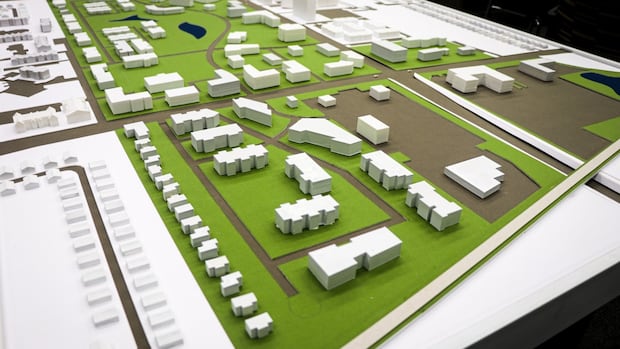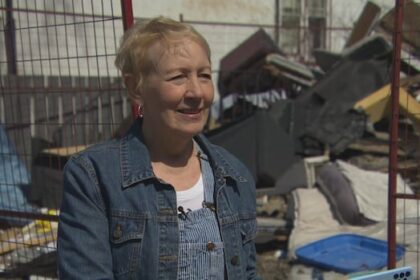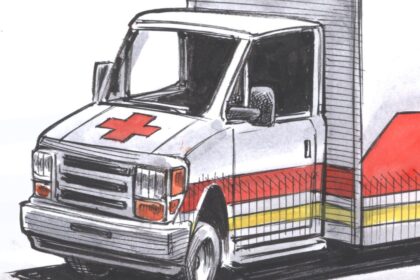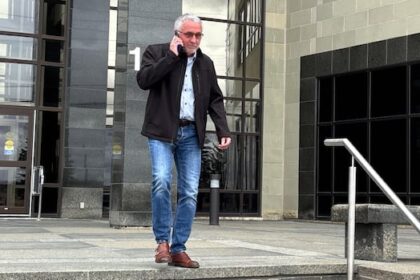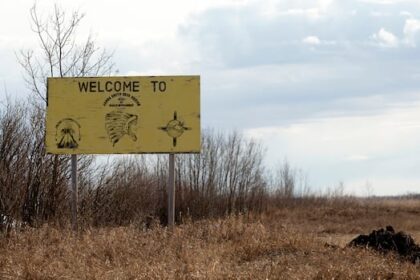ManitobaNaawi-Oodena, the site of the former Kapyong Barracks in Winnipeg, has been chosen as one of the places where a newly created agency will put up some of the thousands of affordable units the federal government plans to build across Canada.Winnipeg one of 6 cities chosen in plan to build thousands of modular homesArturo Chang · CBC News · Posted: Sep 18, 2025 6:00 AM EDT | Last Updated: 10 hours agoPrime Minister Mark Carney participates in an announcement for the new federal agency Build Canada Homes in Ottawa on Sunday. The Canada Lands Company has now confirmed some of the 4,000 modular units the agency plans to build starting next year will be at Naawi-Oodena in Winnipeg, formerly the Kapyong Barracks. (Justin Tang/The Canadian Press)Naawi-Oodena, the site of the former Kapyong Barracks in Winnipeg, has been chosen as one of the places where a newly created agency will put up some of the thousands of affordable units the federal government plans to build across Canada.A portion of the site will get some of the 4,000 modular units the Build Canada Homes agency plans to build starting next year, said a Wednesday email from the Canada Lands Company, a federal Crown corporation focused on real estate and development.That’s following the federal government’s announcement Winnipeg would be one of six cities picked for the agency’s initial projects.Shauna MacKinnon, a member of the Right to Housing Coalition in Winnipeg, said low-income housing is needed across the city.”If we’ve got land available there, then it’s a good use of that land,” she said.The Build Canada Homes agency, formally announced this past weekend, was created in an effort to centralize oversight of new federal affordable housing programs. The federal government said its main focus will be non-market housing for a mix of income needs.The government said the initiatives’ 4,000 factory-built units will be on federal land, with further capacity to expand that number to up to 45,000 units.Canada Lands owns 32 per cent of Naawi-Odena, a former Canadian Armed Forces barracks west of Kenaston Boulevard at Grant Avenue. The remainder of the 65-hectare site officially became Canada’s largest urban reserve in 2022, when the land was repatriated by a group of seven Treaty 1 First Nations.A 3D model of the Treaty One Development Corp. project at the Naawi-Oodena site. About two-thirds of the 65-hectare site was repatriated by a group of seven Treaty 1 First Nations in 2022, and the remainder is owned by Canada Lands, a Crown corporation. (Treaty One Development Corporation)”The former Kapyong site is probably of the size and scale where you could really make an impact with some of these 4,000 homes,” Jino Distasio, director of the Institute of Urban Studies at the University of Winnipeg, said in an interview Tuesday, before the former barracks was officially confirmed as a site.Finding other “small bits and pieces throughout the city … can still have some impact, but it’s a bit more time-consuming to identify, convert those lands,” he said.Distasio said the last thing the government wants to do is to choose isolated places that can’t sustain themselves in the long term, and that building “fast and wherever possible” will not set up communities for success.”Hopefully goal number 1 is to really get some signature properties that make sense for quality residential homes to be built,” he said. “We want to build good, thriving neighbourhoods in places that make sense.”MacKinnon said any location chosen for the federal initiative must be close to services.Naawi-Oodena is “certainly within walking distance to grocery stores and things like that,” she said.”Not sure what the bus service is there, but that would be something again, that would need to be addressed for people who need public transportation.”‘Lots of unknowns’The federal government earmarked $13 billion for the new agency, including $1 billion for transitional and supportive housing for people who are homeless or at risk of homelessness.Jackie Hunt, senior strategy director at End Homelessness Winnipeg, said the federal government is the only entity with deep enough pockets to build the homes needed for “getting us out of this housing crisis.””I’m optimistic that they recognize the need, specifically in Winnipeg,” she said, and she’s hopeful plans will include an array of different types of housing to accommodate people’s needs.”When we look at housing, we have to either look at transitional or long-term supportive, because often people who are experiencing homelessness have additional requirements beyond just a roof over their head,” she said.”If the federal government is going to put up the housing, my hope is that the federal government or the province might be able to support the operational piece of it.”MacKinnon said that while she’s hopeful, there’s “lots of unknowns” about the housing.”They talk about … ‘deeply affordable,'” she said. “We don’t know what that means. From our perspective, ‘deeply affordable’ would mean the rent geared to income, where people are paying no more than 30 per cent of income on rent.”The main issue is whether there will be operating funds to support that housing over the long term, she said.ABOUT THE AUTHORArturo Chang is a reporter with CBC Manitoba. Before that, he worked for CBC P.E.I. and BNN Bloomberg. You can reach him at arturo.chang@cbc.ca.With files from Josh Crabb
Monday, 22 Dec 2025
Canada – The Illusion
Search
Have an existing account?
Sign In
© 2022 Foxiz News Network. Ruby Design Company. All Rights Reserved.
You May also Like
- More News:
- history
- Standing Bear Network
- John Gonzalez
- ᐊᔭᐦᑊ ayahp — It happened
- Creation
- Beneath the Water
- Olympic gold medal
- Jim Thorpe
- type O blood
- the bringer of life
- Raven
- Wás’agi
- NoiseCat
- 'Sugarcane'
- The rivers still sing
- ᑲᓂᐸᐏᐟ ᒪᐢᑿ
- ᐅᑳᐤ okâw — We remember
- ᐊᓂᓈᐯᐃᐧᐣ aninâpêwin — Truth
- This is what it means to be human.
- Nokoma


